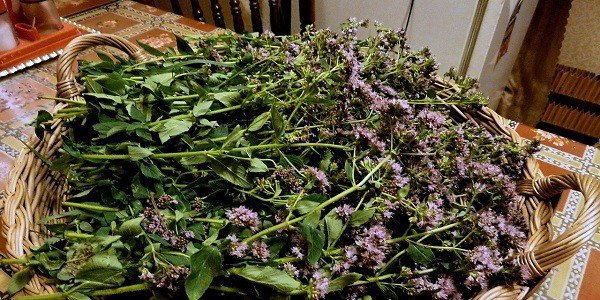Oregano

Oregano is a perennial herbaceous plant belonging to the Lilac family, up to 90 cm tall, with a strongly branched rhizome. It has a pleasant smell reminiscent of thyme.
The rhizome of the plant is brown in color, its stem is erect with small hairs. Oregano leaves are oblong-ovate and dark green with translucent nodules.
Its flowers are small, fragrant, reddish-purple or rose-purple.
Oregano fruits consist of four glabrous, brown or darker nut-shaped seeds located in a calyx.
This plant blooms in July-August, and its fruits ripen in late August, early September. Propagation is by seeds or vegetatively.
Oregano is widely distributed throughout Eastern Europe, growing usually in groups of several plants on sandy and clayey dry soils and on moist coniferous and mixed forests.
Nutritional value of 100 grams of oregano
• Proteins – 1.5 grams;
• Fats – 0 grams;
• Carbohydrates – 5 grams;
• Mineral salts – 1 gram;
• Water – 90 grams;
• Calorie content – 27 kilocalories;
Since the energy value of 100 grams of oregano is 25 kilocalories, and its tea has 27 kilocalories, it belongs to the group of dietary foods and is recommended for everyone, including those who suffering from excess weight.
Beneficial properties
Oregano contains essential oil /0.5-1%/, which includes phenol, thymol and its isomer carvacrol and tricyclic sesquiterpenes, tanning substances, pigments, ascorbic acid – in 166 mg in the flowers, in the leaves 565 mg and in the stems 58 mg.
This spice has high antibacterial activity, has a calming effect on the central nervous system, normalizes the function of the gastrointestinal tract and enhances intestinal peristalsis, and also has a choleretic, anti-inflammatory and diuretic effect.
Medicines containing oregano are prescribed for neurosis, hysteria, insomnia, epilepsy, hypertension, atherosclerosis, for neurotic complaints during the menopause, for spasms of the stomach and intestines, for intestinal atony, chronic gastritis, ulcer disease of the stomach and duodenum, as well as in diseases of the liver and gall bladder.
In Bulgaria, the aerial part of the oregano, collected during the flowering period, is recommended for stomach and intestinal spasms, for nervous tension, painful menstruation, for increased sexual excitability, and also for liver diseases and jaundice. Strong oregano tea causes profuse sweating.
As an herb, oregano is used for eczema and is used by adding it to the water in the bath, and also for washing wounds / 100 grams of the plant in its raw form is put in 2 liters of water and the resulting mixture is added to the water in the bath./
For bronchitis, pneumonia, bronchiectasis, bronchial asthma, the aqueous infusion of oregano is suitable as an excellent diaphoretic and expectorant. It is also recommended to drink for epilepsy for 3 years.
In folk medicine, as an herb, oregano is used for colds, sore throat, cough, tuberculosis, thrush, hypertension, diathesis, stomach and intestinal diseases.
Infusion of oregano is used as a remedy that is added to the bath water for rickets, scrofula, itchy rashes, boils and other skin diseases.
Contraindications
Oregano is highly inadvisable during pregnancy, as it causes uterine spasms, which can cause miscarriage. Excessive regular use of oregano tea can lead to impotence.



